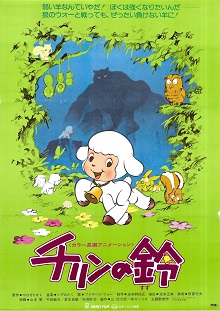Ringing Bell
Ringing Bell (Chirin no Suzu) is a 1978 Japanese animated film directed by Masami Hata and produced by Sanrio, the company known for creating Hello Kitty. The film is based on the children's book by Takashi Yanase, a well-known Japanese writer and illustrator. It is a dark and emotional tale that contrasts sharply with Sanrio's usual light-hearted fare. The story revolves around Chirin, a lamb whose life changes drastically after his mother is killed by a wolf. Seeking revenge, Chirin pursues the wolf but ultimately becomes his apprentice, leading to a complex relationship between predator and prey.
Plot[edit | edit source]
The story begins in an idyllic meadow where Chirin, a cheerful and innocent lamb, lives peacefully with his mother and the other animals. However, their tranquil life is shattered when a wolf kills Chirin's mother. Consumed by grief and a desire for vengeance, Chirin sets out to find the wolf, intending to kill him. Instead, the wolf, recognizing Chirin's determination, decides to take him under his wing. Chirin, who once admired the peaceful life of the meadow, is trained in the ways of the wilderness and becomes a fierce fighter under the wolf's guidance. As Chirin grows, he struggles with his identity and the consequences of his choices, leading to a poignant conclusion.
Themes[edit | edit source]
Ringing Bell explores themes of loss, revenge, identity, and the cycle of violence. It challenges the conventional boundaries between good and evil, showing how circumstances can transform innocence into bitterness. The film also delves into the concept of nature versus nurture, as Chirin's upbringing by the wolf shapes him into a creature vastly different from the lamb he once was. The complex relationship between Chirin and the wolf raises questions about the meaning of strength and the cost of survival.
Reception[edit | edit source]
Upon its release, Ringing Bell received mixed reviews due to its dark themes and unexpected narrative direction, especially from an animation studio like Sanrio known for its cute and wholesome characters. However, over the years, it has gained a cult following and is praised for its emotional depth, unique storyline, and the way it addresses complex themes. It is considered a departure from the typical children's animation, offering a story that resonates with both adults and children.
Legacy[edit | edit source]
The impact of Ringing Bell extends beyond its initial reception. It is regarded as a pioneering work that broadened the scope of animated films, demonstrating that they could tackle serious and mature themes. The film has influenced a generation of storytellers and animators who seek to explore the darker aspects of life and human nature through animation. Ringing Bell remains a significant work in the history of animated films for its bold narrative choices and its exploration of themes that challenge the viewer's expectations.
Transform your life with W8MD's budget GLP1 injections from $125 and up biweekly
W8MD offers a medical weight loss program NYC and a clinic to lose weight in Philadelphia. Our W8MD's physician supervised medical weight loss centers in NYC provides expert medical guidance, and offers telemedicine options for convenience.
Why choose W8MD?
- Comprehensive care with FDA-approved weight loss medications including:
- loss injections in NYC both generic and brand names:
- weight loss medications including Phentermine, Qsymia, Contrave, Diethylpropion etc.
- Accept most insurances for visits or discounted self pay cost.
- Generic weight loss injections starting from just $125.00 for the starting dose
- In person weight loss NYC and telemedicine medical weight loss options in New York city available
Book Your Appointment
Start your NYC weight loss journey today at our NYC medical weight loss, and Philadelphia and visit Philadelphia medical weight loss Call (718)946-5500 for NY and 215 676 2334 for PA
Search WikiMD
Ad.Tired of being Overweight? Try W8MD's NYC physician weight loss.
Semaglutide (Ozempic / Wegovy and Tirzepatide (Mounjaro / Zepbound) available. Call 718 946 5500.
Advertise on WikiMD
|
WikiMD's Wellness Encyclopedia |
| Let Food Be Thy Medicine Medicine Thy Food - Hippocrates |
Translate this page: - East Asian
中文,
日本,
한국어,
South Asian
हिन्दी,
தமிழ்,
తెలుగు,
Urdu,
ಕನ್ನಡ,
Southeast Asian
Indonesian,
Vietnamese,
Thai,
မြန်မာဘာသာ,
বাংলা
European
español,
Deutsch,
français,
Greek,
português do Brasil,
polski,
română,
русский,
Nederlands,
norsk,
svenska,
suomi,
Italian
Middle Eastern & African
عربى,
Turkish,
Persian,
Hebrew,
Afrikaans,
isiZulu,
Kiswahili,
Other
Bulgarian,
Hungarian,
Czech,
Swedish,
മലയാളം,
मराठी,
ਪੰਜਾਬੀ,
ગુજરાતી,
Portuguese,
Ukrainian
Medical Disclaimer: WikiMD is not a substitute for professional medical advice. The information on WikiMD is provided as an information resource only, may be incorrect, outdated or misleading, and is not to be used or relied on for any diagnostic or treatment purposes. Please consult your health care provider before making any healthcare decisions or for guidance about a specific medical condition. WikiMD expressly disclaims responsibility, and shall have no liability, for any damages, loss, injury, or liability whatsoever suffered as a result of your reliance on the information contained in this site. By visiting this site you agree to the foregoing terms and conditions, which may from time to time be changed or supplemented by WikiMD. If you do not agree to the foregoing terms and conditions, you should not enter or use this site. See full disclaimer.
Credits:Most images are courtesy of Wikimedia commons, and templates, categories Wikipedia, licensed under CC BY SA or similar.
Contributors: Prab R. Tumpati, MD



